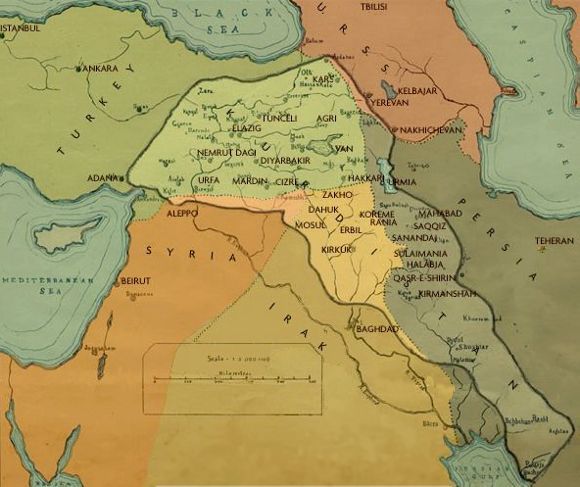KurdistanThe transition from hunter gathering to settled communal living allows time for experimentation, and in Kurdistan this led to the development of the very first metallurgy in the Old World. Two sites have confirmed the use of copper instruments as early as the first half of the fifth millennium BC, while even earlier evidence of copper deposits and a single lead bead have been detected at an important protoneolithic site named Jarmo, situated on the Lesser Zab river in Iraqi Kurdistan. These examples could well date to as early as 6750 BC, some 350 years before copper and lead smelting is known to have been practised at Catal Huyuk in central Anatolia, c. 6400 BC.
At another site, a huge cave in Iraqi Kurdistan situated high above the Greater Zab river some 520 kilometres (325 miles) east-north-east of Abu Hureyra and known locally as Shanidar, palaeontologist Ralph Solecki unearthed a slim, almond-shaped piece of copper. This object had two equally spaced perforations at its end so that it could be worn as a pendant around the neck. The context in which it was found indicates a date of around 9500 BC, making this the earliest example of a copper artefact. Its presence at the site was almost certainly connected with the nearby settlement of Zawi Chemi, whose inhabitants are known to have used grinding stones to produce flour from wild cereal grains as early as the tenth millennium BC. The workmanship of this hammered object made from unsmelted copper ore is quite extra ordinary and suggests an extremely long time-frame during which this style of copper work was developed - telling evidence that this trade began long before 9500 BC. There is even a possibility that it might have been an heirloom from an earlier culture, as there is no evidence for the use of hammered copper objects until 7200 BC, some 2300 years later, when they seem to reappear quite suddenly at an important Neolithic village, located some 400 kilometres (250 miles) west-north-west of the Shanidar cave. Known today as Cayonu, it lies 60 kilometres (37 miles) north of Diyarbakir, the present capital of Turkish Kurdistan. Here archaeologists Robert Braidwood and Halet Cambel discovered four early copper items - two pins, one bent fish-hook and a reamer or awl - showing that its inhabitants had become proficient metalworkers by this age. The noted craftsmen of Cayonu went on to produce many other copper items, including oval-shaped beads, as the trade spread gradually to other major sites in the region. That metallurgy should have developed first in Kurdistan was perhaps inevitable, for both the Zagros and Taurus mountain ranges are teeming with ore deposits, so much so that the area surrounding the Neolithic site of Cayonu, some 120 miles east-south-east of Lake Van, has been producing copper and bronze objects non-stop for the past seven thousand years. However, as R. J. Forbes pointed out in The Birthplace of Old World Metallurgy, ‘in the ancient Near East, the supply of native copper was quickly exhausted and the miner had to turn to ores.’This required the knowledge and ability to find and extract the ores, crush them, then smelt and refine them - processes that could not have been carried out without kiln-type furnaces and a generally advanced technology.
|
The Ray Smith Notebook of Metalworking Orgins - Copyright © 2002 Ray Smith
HTML Copyright © 2002 Jock Dempsey